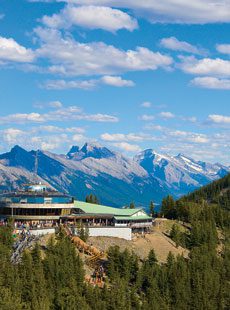Mountain for the Masses – Sulpher Mountain, Banff
Sulphur Mountain has a relatively mild gradient, making it a safe and rewarding peak for novice mountain runners.

 If you’ve ever earned a summit view under your own power, you likely understand the attraction of mountain running. It’s more than just running up and down peaks. It’s also an opportunity to experience wild and scenic spaces, while pushing your body’s limits.
If you’ve ever earned a summit view under your own power, you likely understand the attraction of mountain running. It’s more than just running up and down peaks. It’s also an opportunity to experience wild and scenic spaces, while pushing your body’s limits.
The rugged peaks throughout Banff National Park make it a mountain running paradise. However, not every mountain run in the park needs to be a huge production, requiring a great deal of fitness and gear. Sulphur Mountain is one of the more accessible runs.
It’s most famous for the hot springs at its base. In 1883, when Canadian Pacific Railway (CPR) was completing the railroad, three workers stumbled upon a small circular basin filled with warm water at the base of a mountain. Although the First Nations of Bow Valley have known about the sulphur hot springs for centuries, the CPR discovery had a profound effect on the region.
At 2,270 metres, Sulphur is the highest mountain in the Banff area. Meteorologist Norman Sanson made the first reported ascent in 1896, making the trek in snowshoes. Towering over the town, the summit offers stunning panoramic vistas of nearby, burly, iconic peaks in the Bow River Valley. Today, shuttles drive thousands of tourists to the peak each day via a gondola, which runs from the hot springs. There is a restaurant, gift shop and cafeteria at the summit, along with a viewing platform, picnic tables and interpretive signs.
For runners and snowshoers who like to earn their view away from the hordes, a well-maintained 5.3K trail climbs 660m in elevation, along snaking switchbacks, from the Upper Hot Springs parking lot to the summit, with the gondola swinging above the trail.
At the summit, there are a few short, tourist clogged, side trails that run along the ridge that you can take to extend the run and expand your view. You can also run from town, adding 170m of elevation, by running along a series of urban trails before joining Mountain Avenue to the trailhead.
The altitude and elevation of the trail make it a good fitness test for many of Canada’s elite endurance athletes; however, it has a relatively mild gradient, making it a safe and rewarding peak for novice mountain runners. Depending on your fitness, you can run laps up and down the trail, or you can run up at a leisurely pace, take in the views and grab a bite to eat and a drink, before enjoying a trip down the gondola, then head to the Hot Springs to recover.
The footing is good and the trail is open year round, but it does get snowed in and can be icy during the winter and shoulder seasons. It can also get quite muddy and slippery following rains and thaws. Being in the mountains, the weather can change quickly and the summit can be significantly cooler than the base, so pack extra clothes for the run.
For other runs in the region: Refer to Mountain Running in the Canadian Rockies: Bow Valley Edition, by Bob Walker
Getting There: From Calgary, drive Highway 1 west into Banff National Park. Shortly beyond the park entrance, take the Banff townsite exit. Proceed south through downtown on Banff Avenue. Cross the Bow River bridge and turn left onto Spray Avenue. Bear right on Mountain Avenue, and follow the sign for the hot springs. Follow it 3.3K to the upper parking lot.
Adam Campbell is a competitive trail-runner based in Vancouver.


